
Denamarin, manufactured by Nutramax, is a supplement used in veterinary medicine as a liver protectant and to promote healthy liver function. In this article you’ll learn about the ingredients in Denamarin, what they do for liver health, important dosing information, and some frequently asked questions.
Denamarin for Cats Overview

About Denamarin for Cats
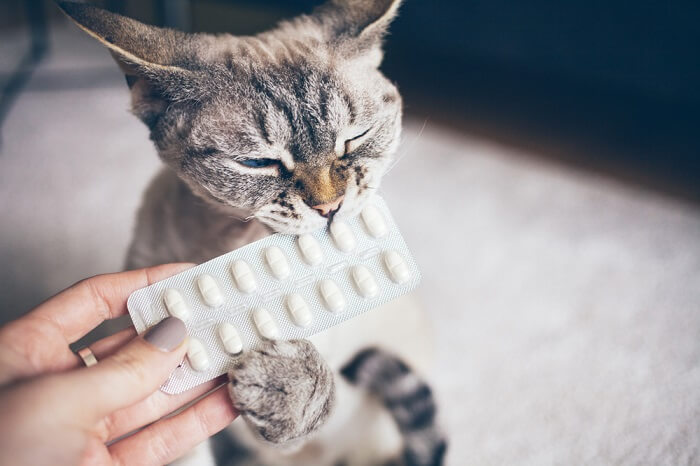
Denamarin is a liver health supplement that contains the two main ingredients s-adenosylmethionine (SAMe, pronounced “sam-ee”) and silybin.
As a nutraceutical, Denamarin is not considered a medication, and more of a health supplement for liver support, but it is used very widely in veterinary medicine as an adjunctive treatment for various kinds of liver disease, as well as for pets on long-term medications that may stress or damage liver function over time.
SAMe is a natural compound made by cells throughout the body. It is an essential part of three major metabolism pathways that the liver uses.
Silybin is the major active component of silymarin, which is found naturally in the milk thistle plant. Silybin acts as a liver protectant chiefly through preventing toxin penetration into liver cells. It also inhibits toxic and inflammatory effects on cells, and acts as an antioxidant and free radical scavenger.
Free radicals are unstable atoms that roam the body, causing damage to cells. Antioxidants acting as free radical scavengers have the ability to bind these atoms and deactivate them. Many compounds in nature can act as antioxidants.
While SAMe and silymarin may be found themselves as supplements, their combination in a dosage form for pets is proprietary to the Denamarin product.
What Does Denamarin Do for Cats?
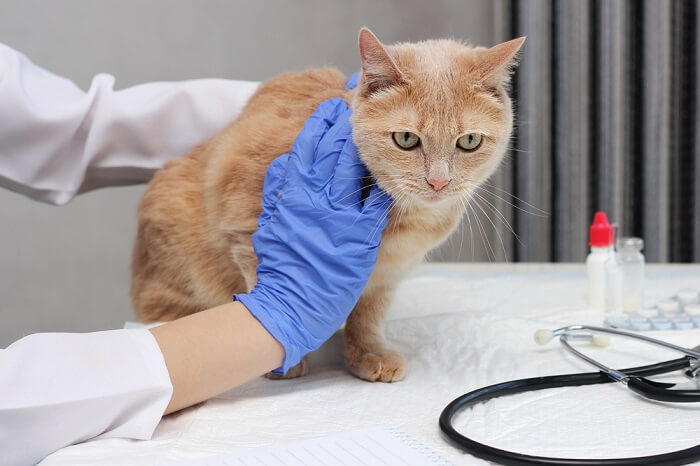
Denamarin helps to protect liver cells from toxins and inflammatory damage, and improves liver function.
The ingredients in Denamarin can help to protect liver cells from toxins and inflammatory damage through the actions of silybin, as well as improve liver function through SAMe’s involvement with major metabolic processes of the liver.
Denamarin may be recommended as part of a treatment plan for a variety of circumstances where the liver is involved. In cats, this can include conditions where liver enzymes are elevated on bloodwork like in cholangitis/cholangiohepatitis syndrome, hepatic lipidosis, and feline triad disease/triaditis.
Denamarin may also be used when treating toxicities that affect the liver, including acetaminophen toxicity. There are also some medications necessary to use to treat some types of diseases, and these medications may put additional stress or strain on the liver. Denamarin can be helpful in protecting the liver from some of these effects while the medication is being used.
Side Effects of Denamarin for Cats
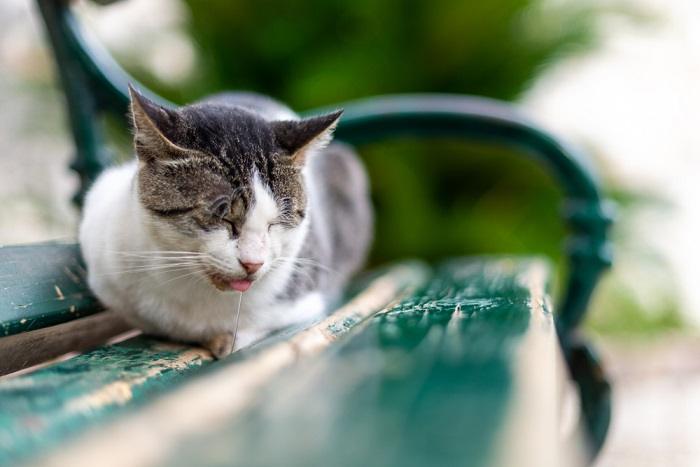
Fortunately, side effects to Denamarin appear to be minimal. Toxicity studies have shown no adverse effects in pets at typical doses that are prescribed, and overdoses are unlikely to cause serious illness. In people, side effects of SAMe are also, rare but vomiting and decreased appetite have been reported.
It is important to remember that administration of a tablet to a cat may result in a distaste response, either to the medication itself or to the process of medicating. In some cats, this may lead to hypersalivation (drooling), hiding, and rarely vomiting.
While this is not considered a true medication reaction, if you have any concerns about a true toxicity, make sure to call the ASPCA Animal Poison Control Center (1-888-426-4435), or Pet Poison Helpline (1-855-764-7661) for further advice.
Although natural products and considered very safe, SAMe and silybin have not been studied in pregnant or nursing queens, so Denamarin should be used cautiously in these kitties.
Denamarin for Cats Dosage
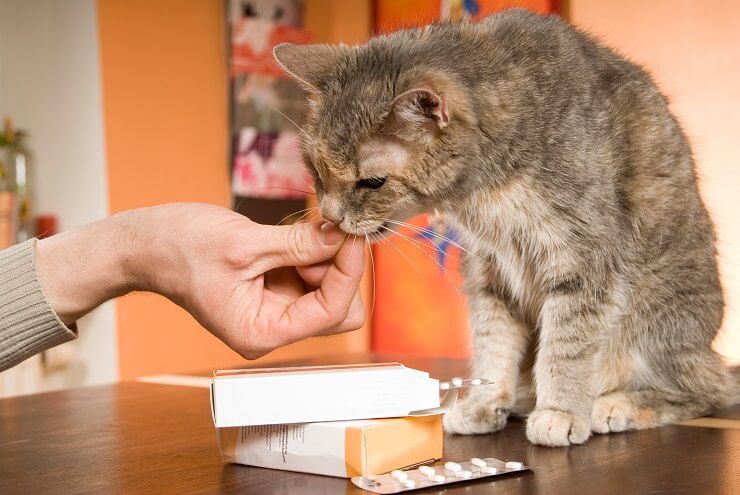
Denamarin is given on an empty stomach, but you can hide the tablet in a small amount of food if necessary.
There is only one dosage of Denamarin available for cats, which is the Denamarin for Cats and Small Dogs product, which contains 90mg of SAMe and 9mg of silybin.
Denamarin tablets are typically dosed once a day per the manufacturer’s advice. However, there are many reports that the most effective dosages for SAMe and silybin for certain conditions may need to be higher than the Denamarin label states.
Some patients on Denamarin long-term may also continue to benefit from administration every two to three days. This is why it is very important to follow your veterinarian’s instructions very carefully.
The Denamarin tablets should be kept in their original packaging until used and should not be crushed or split (i.e., you should not split larger doses formulated for dogs to give to a cat).
Denamarin must be given on an empty stomach. Approximately one hour before feeding or two hours after feeding, is best.
Dry pilling tablets is generally discouraged in cats. When giving a Denamarin tablet, you can give three to six milliliters of water immediately after administration to aid in its passage down to the stomach. If needed, a Denamarin tablet can be inserted into a very small amount of food, or something like a Pill Pocket, to make administration easier.
While SAMe and silybin/silymarin (or milk thistle) can be found in supplement form for humans as well, these products can have a great degree of variability in active ingredients and are not designed for pets.
Denamarin has been developed for and formulated for pets. Always make sure to discuss any supplements you might plan to use for your cat with your veterinarian.
Conclusion
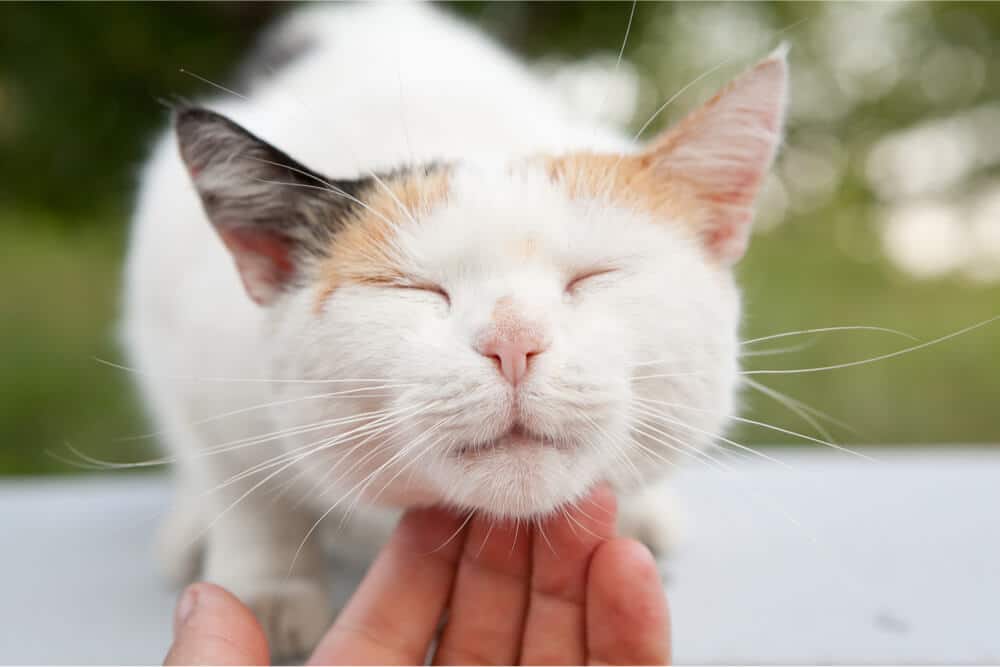
It can be normal for some cats to drool a little when they are very relaxed and content.
Denamarin for cats is a very useful nutraceutical that is part of every vet’s toolbox for treating cats with liver disease or toxicities affecting the liver. It is generally very safe to use, though the need to give it without food can be a little challenging for some kitties.
Effective dosages may vary depending on the condition, necessitating following all veterinary instructions carefully.
Frequently Asked Questions
What does Denamarin do for a cat?
Denamarin is a non-drug, nutraceutical supplement widely used by the veterinary profession to aid in treating certain types of liver disease or toxicities affecting the liver in cats and dogs. It can also help to protect the liver from damage if a cat has another medical condition requiring a medication that may put stress or strain on liver function and metabolism.
Can Denamarin be given to cats?
Yes, there is a specific dosage size of Denamarin developed for cats. Denamarin is considered very safe to use in cats and side effects are very uncommon.
Why does Denamarin have to be given on an empty stomach?
Primarily, this is because the presence of food has shown to decrease the absorption of the SAM-e ingredient. So while it can technically be given safely with food, the product will lose some of its efficacy.
Dry pilling cats is generally not recommended because tablets have been shown to stay lodged in the esophagus, so any tablet given without food should be followed with three to six milliliters of water.
The manufacturer does also say that if necessary, Denamarin can be given disguised with a small amount of food, such as a Pill Pocket.
Can Denamarin advanced be used in cats?
Denamarin Advanced is very similar to regular Denamarin. The main difference is a variation in the SAMe component making it more bioavailable in the Advanced formulation.
There are both chewable and traditional hard tablet forms available for dogs, but currently only a hard tablet form is available for cats.
Unlike regular Denamarin, Denamarin Advanced may only be available for purchase directly through your veterinarian. If you already have this at home for a canine companion, make sure to discuss with your veterinarian first before using it for your cat.


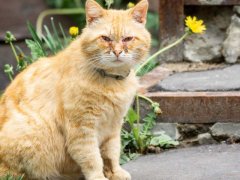





My veterinarian has subscribed Denamarin for my 13 year old cat. I feel like I’m traumatizing my little Rusty every time I try to give him this small pill. Is it possible that this medication is available in liquid form or can I dissolve the pill in a small amount of water or liquid gravy? Over the past 2 weeks I’ve only been able to get him to take 10 doses. I can see a remarkable improvement in his health and weight but I hate traumatizing him.
Thank you
Steven
Hi Steven,
Great questions. As you’re likely aware from reading the article, Denamarin is best absorbed on an empty stomach. However, because of the trouble many pet parents can have trying to administer just the plain pill, many vets will advise giving it in the tiniest amount of food to help with administration, like a pill pocket, small morsel of canned food, or as you mentioned, a little gravy to help with palatability and ease it down. Mostly you want to avoid giving with a full meal and you don’t want to crush it, mix it, or dissolve it in anything, as this will affect its absorption.
You may also ask your vet about Denamarin Advanced, which is a chewable tablet only available from a vet’s office. There is no version just for cats, but some vets are comfortable using the small dog version off-label in cats. Of course, no guarantee your kitty will chew it, but just another thought.
Dr Vanderhoof,
I appreciate your quick response to my question. Unfortunately my cat only eats dry food. I was hoping that by pulling up his food dishes a few hours before administering his meds that he might be hungry enough for wet food but that hasn’t been the case. The pill is actually the size as the food nuggets. I suppose I’m not being aggressive enough in giving him the pill but when I give it to him he foams at the mouth and his tongue is going a mile a minute spitting out the pill. Then he hides under the bed for hours to avoid me. I’ve asked my veterinarian to see if the same type of medication is available in a liquid form as it’s much easier to give him liquids.
But I do appreciate your response and input.
Have a wonderful Thanksgiving
Steven
Sure thing, Steven, and the same to you. Something to assist with the taste when pilling may still help, like a little gravy or pill pocket. Might still go down a little easier with less revulsion. Unfortunately, no liquid form exists to my knowledge and as there is no generic form for this supplement, I have not heard of it being compounded into another form either. Even if dry pilling is the most effective for you, providing some kind of high-value treat afterwards may help reduce the negative association.
My vet recently prescribed Denamarin for my 4 yr old cat. This isn’t his first go around on this medication but this time it seems to really be upsetting his stomach and causing vomiting spells. I usually pick up his food 2-4 hours before administering the pill and wait 2 hours after to feed him again in hopes of preventing nausea. He’s only 3.3kg and I’m concerned a whole pill of the Denamarin may be too much for him? They gave me Cerenia to curb his nausea and it works great. But I’m thinking half a pill would be easier on his stomach and still do what it’s intended given his weight. Is vomiting normal with Denamarin? Especially in a cat that may have a sensitive stomach/GI issues? (Still working with the vet on a formal diagnosis but signs seem to point to a sensitive stomach)
Hi Morgan,
Vomiting with Denamarin is very uncommon in cats, but it has been reported.
You are correct that Denamarin should not be given with food and this is because food decreases absorption of the SAMe.
However, dry-pilling cats can cause challenges, so it is commonly recommended to follow any dry pilling event with 3-6ml of water to ensure it goes down. It is also feasible to coat the tablet in a very small amount of food (sometimes bits of Pill Pockets are useful for this) to help it go down easier, and this may help with some cats with palatability in case that’s leading to any kind of nausea.
If you’re using the regular enteric-coated tablets, these should not be split or crushed as it will affect the absorption as well as the dosage, so I wouldn’t do that without speaking with your vet first.
There are some vets who will use the Denamarin Advanced chewable tablets for small dogs with a cat, since the dosage is still appropriate and because the chewable form may make dosing easier. Not all offices carry the Advanced formulation though and it is difficult to find online as well. It may not be an available option, but worth mentioning.
If the Denamarin is truly helping an underlying condition, it certainly can be worth adding in the cerenia to help with rare vomiting if it does occur. Hopefully this is a condition that can be healed up. I wish you and your kitty luck!
Recently a senior kitty of our’s needed to go on Denamarin Advanced to try and get his liver numbers improved. This senior fellow does not like any medication, in any form, of any taste…lol. You can’t hide it in his food – wet or dry – and he will fight/squirm to the max if you try to pill him.
But seeing that liquid alternatives such as Liquid Hepato (chicken flavored) and dirt tasting Milk Thistle didn’t yield better results – we went back to the small Denamarin Advanced pill.
The first time we tried it, the pill got stuck in his mouth and he eventually coughed it out. The next time I took just a little bit of the Costco brand pill pocket. It’s bacon flavored and what animal doesn’t like bacon! Plus it’s just a bit oily on the surface so I figured it wouldn’t stick in his mouth or further down.
The pill isn’t too big so I use just a pinch, a very small amount, from the pocket to wrap around the pill. The Costco pocket is very malleable and like mentioned is a bit slick-oily feeling on the surface.
We “pill” him just before we go to bed, long after any meal, my wife holds him firmly and I open his mouth just enough to pop it in. I then close/hold his mouth closed, using just enough pressure to keep it shut. He licks a bit and I blow just a little air towards his nose until it feels like it must be swallowed.
For about three weeks now this has yielded about 95% success on the first try. A few times he’s super sneaky and spit it out…lol.
But I think the combo of my wife securely holding him, myself being direct-firm but not too strong armed, with pill-in-a-thin-layer-oily-pocket is a workable solution for all three of us. All together I’d say we complete everything in about a minute to 2-minutes, so he’s not stressed long at all.
Hope these tips helps!
Thanks for sharing your tips Vinton!
I own a 16/ year old female neutered cat who was given a diagnosis n prescribed Denemarin n ( She is not taking the medication I notified (Banfield Veterinarian Asked is it available in liquid n told ( Milk Thistle ) I Haven’t purchased yet n after researching It is not better for cats) I Decided recently -Pill pockets N seems to be working ) Is it okay to have a pill pocket with Tablet in it with small amount of water ?
Hi Arturo,
While it is best to administer Denamarin on an empty stomach, I have certainly had (especially feline) patients where this is not practical or possible at home. I do feel that administering it with a small piece of pill pocket is okay if that is the most reliable way to administer it. You would still want to give it one hour prior to a full meal (or two hours after) for the best absorption possible.
For milk thistle, this is a supplement that was used prior to Denamarin becoming available. Milk thistle contains silymarin. Silybin, one of the ingredients in Denamarin, is an active component of silymarin. So while helpful, milk thistle will not have the same full benefit as Denamarin.
Have you ever heard of this being used for seizures in cats? My kitten is not taking it well at all. I just discovered it isn’t supposed to be crushed, oops, and I worry about holding him down to force it down his throat as stress can be a trigger for a seizure. I’ve tried kitten milk replacer, a piece of hot dog, and mixing it with wet food. He’s already a picky eater so I don’t know what’s left for me to try other than force.
Hi Barbara,
I have not heard of Denamarin being used for primary seizure disorders (caused by a problem in the brain). Seizures can be caused by liver disease or a liver toxin and in those cases, Denamarin may certainly be part of a therapy approach.
Having to give Denamarin largely without any food on an empty stomach is certainly a drawback. Your vet practice may be able to help you learn some tips for administering a pill directly by mouth. Using a pill popper or pilling gun to get the pill as far back in the mouth as possible followed by closing the mouth, blowing on the nose and massaging the throat is one method. A small amount of water (about 1/2 ml) in a syringe to encourage a good swallow can be helpful. This cats.com article on how to administer a pill may also be helpful: How to Administer Your Cat a Pill (With 7 Proven Tips!)
We have also on occasion prescribed the Denamarin chewable tablet. While this is an off-label use you would have to speak with your vet about, the chewable forms can be broken into smaller pieces which may provide you another option.